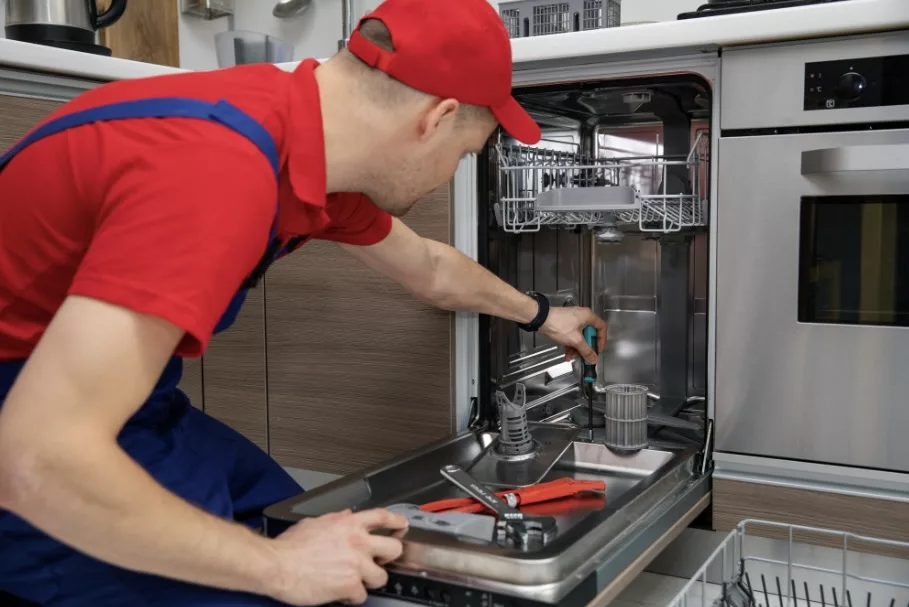
As the modern-day marvel, the dishwasher is a cherished appliance for many in San Antonio, yet from time to time, it can act up, leading to repairs that might make it feel more like a hindrance than a help. One recurring problem most dishwashers encounter sooner or later is slow or non-existent draining. Fortunately, the professionals at Beyer Plumbing are here to guide you through the process of identifying and resolving these dishwasher drainage issues.
GETTING STARTED
If you open your dishwasher to find that it hasn’t drained properly, don’t panic. Rather than trying to immediately pinpoint the issue, it’s best to begin with the simplest solution. It’s possible that accidental interference with your dishwasher’s controls during its cycle disrupted the draining process. In such cases, most dishwashers won’t drain until you rerun the cycle.
An easy way to prevent this is to install a dishwasher that has its controls on top of the door instead of on the front. If it’s not time for replacement, most dishwashers come equipped with locking mechanisms to deter inadvertent button presses.
A CLOGGED DRAIN FILTER
A frequent problem we encounter at Beyer Plumbing regarding slow-draining dishwashers is a clogged drain filter. To many people, the screens at the bottom of their dishwashers that are designed to catch debris look quite complicated. Therefore, rather than following the manufacturer’s recommended instructions for cleaning these screens, they ignore the task until their dishwasher no longer operates properly.
The good news is that these screens, despite their appearance, are relatively straightforward. By following the instructions in your owner’s manual, you can typically remove and clean these screens in under 10 minutes. Neglecting this task results in the accumulation of debris, obstructing water from escaping and leading to standing water in your dishwasher.
A CLOGGED DRAIN HOSE
In some cases, the drain filter in your dishwasher may not catch every last piece of debris, allowing some to pass through and clog the drain hose gradually, causing drainage issues. The dishwasher’s smaller drain hose diameter makes it challenging to clean with conventional methods. In such cases, it may be necessary to have a professional from Beyer Plumbing disconnect the hose for a thorough cleaning.
DISHWASHER SOAP MISTAKE
If you’ve ever been in a hurry to get your dishes cleaned, chances are that you’ve accidentally used dishwashing liquid meant for the sink in your dishwasher. Unfortunately, typical dishwashing liquid is meant to create heavy suds, while soap for dishwashers doesn’t create any suds at all. With the warm water and heavy agitation in a dishwasher, heavy suds can form, leaving you with a big mess to clean up.
Fortunately, the remedy to this problem is straightforward and usually doesn’t necessitate a call for help. All you have to do is use a wet/dry vacuum to remove the excess suds and then run your dishwasher again without any soap. At the end of the extra cycle, you should be good to go.
CONNECTION PROBLEMS
Another essential kitchen tool is the garbage disposal. While some people think of their garbage disposal as an extra trash can, the fact is that a garbage disposal discharges into the same drain as your dishwasher. Therefore, if your garbage disposal doesn’t effectively break down food waste, it could potentially clog the connection point where the garbage disposal and dishwasher drains converge.
In some cases, you may be able to solve this problem simply by running your garbage disposal without adding extra food waste. If that doesn’t work, you may need the experts from Beyer Plumbing to stop by and clean out the connection point. The best way to prevent this problem is to be selective about what you dispose of in the garbage disposal, avoiding items like eggshells and coffee grounds.
IMPROPER LOADING
While your dishwasher is quite adept at washing various loads, there can be times when the loads interfere with the proper operation of the dishwasher. Depending on how the dishwasher is loaded, the sensors inside the dishwasher may detect that the load is complete when water still needs draining. If other solutions prove ineffective, try reloading your dishwasher to see if it resolves the issue.
AIR IN THE LINE
To ensure that all of the water is removed from its lowest components, your dishwasher uses a pump to drain itself at the end of a cycle. In some cases, this pump may draw in air as well as water, which can cause your dishwasher to stop draining. Fortunately, most dishwashers include an air gap located next to your faucet to allow air to escape from the drain. However, this air gap can become clogged, meaning that the air gets trapped in your dishwasher’s drain instead.
In rare cases, you may discover that your dishwasher doesn’t have an air gap installed. If that’s the case, consider having Beyer Plumbing stop by and install one to enhance your dishwasher’s draining efficiency.
FAULTY PUMP MOTOR
Your dishwasher relies on numerous components to clean dishes effectively. One of these components is the pump motor. This device essentially serves as a vacuum that sucks water out of your dishwasher and sends it to the drain. In certain instances, this motor can malfunction, leaving you with a dishwasher full of water. Depending on your dishwasher model, it may be best to have a professional replace this pump for you. In other cases, replacing the dishwasher with a new model might be a more practical solution.
Serving San Antonio for over 30 years, Beyer Plumbing has earned an A+ rating with the Better Business Bureau and garnered countless five-star reviews from our top-notch customers. If you’re grappling with dishwater drainage issues or any other plumbing concerns, don’t hesitate to contact Beyer Plumbing today.
